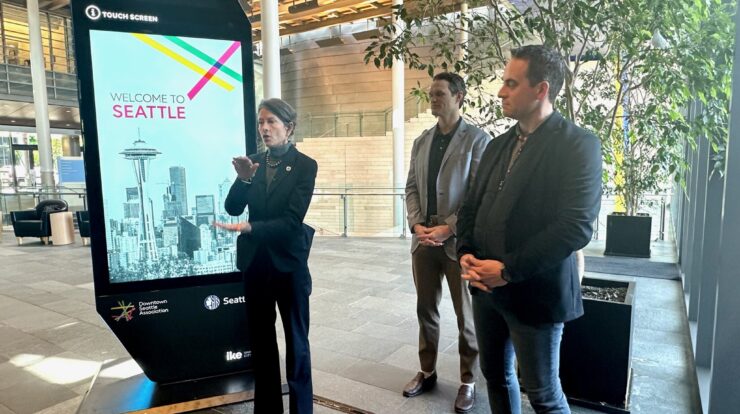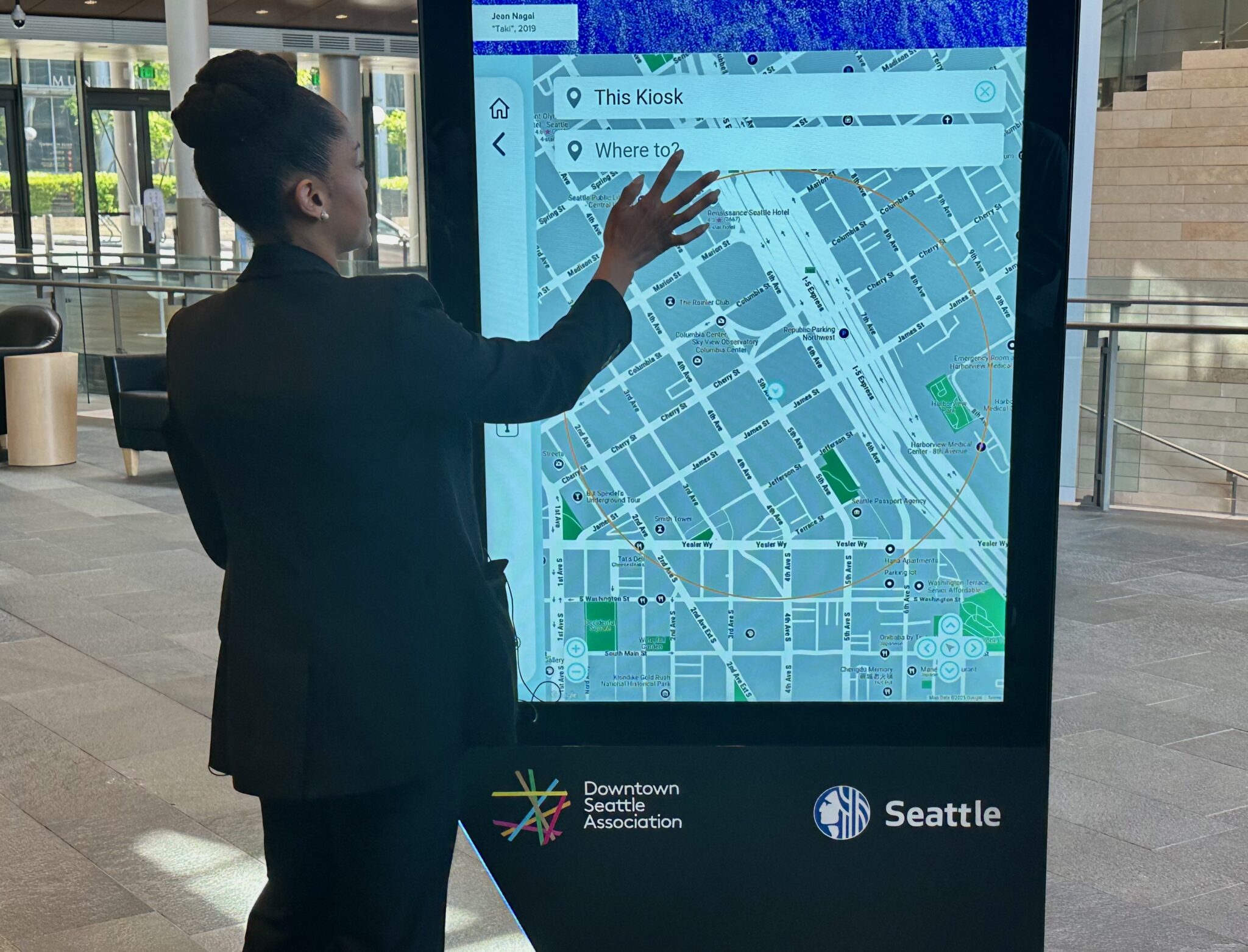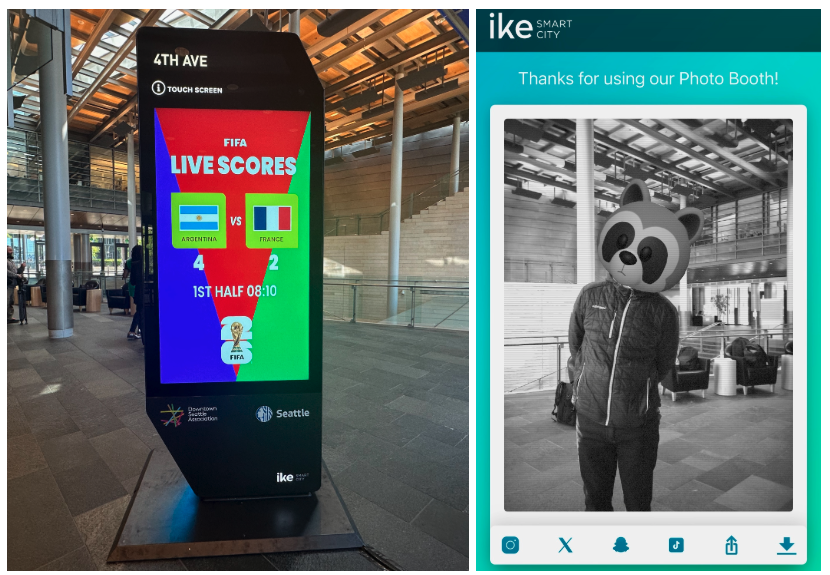
Like a giant smartphone with content tailored to the needs of Seattle citizens and visitors, a large digital wayfinding kiosk was powered up at City Hall on Thursday to demonstrate the look and feel of infrastructure that could be coming to city streets.
The dual-sided, touchscreen kiosks feature Wi-Fi access and can relay information related to transportation, community events, safety, health, arts and entertainment, and more — with advertising included.
The desire to install the devices in the public right-of-way in the downtown core is in support of Mayor Bruce Harrell’s
Downtown Activation Plan
and the effort to revitalize the city post-pandemic.
“This is a proven tool in markets across the country,” said Jon Scholes, president and CEO of the
Downtown Seattle Association
(DSA), the organization that is serving as lead applicant and proponent to bring the kiosks to Seattle. “This will drive traffic and spending into our small business community, our neighborhood business districts, and increase attendance at arts and cultural events or concerts.”
The kiosks, called
IKE Smart City
, are a product of Columbus, Ohio-based advertising company
Orange Barrel Media
, which is partnering with DSA on the proposal. There are currently 23 U.S. cities where the digital kiosk program has been implemented, and the hope among stakeholders is to bring 30 of the devices to Seattle’s Metropolitan Improvement District in time for the
FIFA World Cup
in 2026.

The Seattle City Council’s Governance, Accountability, and Economic Development Committee was meeting Thursday to discuss
Resolution 32170
, which would grant conceptual approval to DSA to install and operate the kiosks. The legislation is one step in the permitting process before a potential vote by the full Council in June.
Seattle City Council President Sara Nelson, who said she has been a strong backer of the project since her first day in office, cited the public benefits and the elevation of small businesses.
“This will generate revenue for our partner, DSA, for providing the essential services that improve the downtown area for everyone who works, lives and visits downtown,” Nelson said. “They provide trash pickup, graffiti removal, additional security — things that the city should do but doesn’t have the resources for.”
There is no cost to the City of Seattle for the installation or upkeep of the kiosks, which could generate, on average, $1.1 million per year via advertising revenue that would go to DSA. The organization says it would invest that money back into downtown. The City would also share in any additional revenue that exceeds an agreed-upon threshold.
Each IKE (interactive kiosk experience) measures just over 8 feet tall and 3 feet wide, with a depth of about 1 foot. The screen size is 12 1/2 square feet and can be interacted with like any smart touchscreen, with users scrolling through city-specific apps and content, such as maps, nearby restaurant listings, the city’s
Find It, Fix It app
, and more. There is also a button on the side of each kiosk which allows for 911 calls.

Clay Collett, the senior development director at IKE Smart City, stated that his company isn’t aiming to rival anyone’s mobile device. Instead, these kiosks are designed to provide broader access to technology for individuals without smartphones and also serve as guides for visitors unfamiliar with navigating through a new city using just their phones.
What we aim to achieve is providing an enhancement, and what we aspire to offer is a highly localized experience,” Collett stated. “The material displayed in the city section as well as across all our apps will be tailored specifically for Seattle by Seattle residents, aimed at supporting local enterprises.
Scholes emphasized that the kiosks focus on “exploration,” regardless of whether someone resides locally or is just visiting.
He mentioned, ‘You might not be aware of things you’re ignorant about.’ It’s crucial to grasp what surrounds us so we can engage with our environment. Simply owning a phone isn’t enough to provide those insights.
When idle, the kiosk displayscreens rotate through eight different visuals. These images consist of 25% city-related information and 75% advertisements aimed at generating revenue for the project. A number of these slides also showcase local art pieces.
If a user taps the screen of a kiosk, the displayed information will pertain to what is situated near that particular kiosk.
Apart from the kiosks situated in the downtown area, roughly 20 additional kiosks might be placed within Business Improvement Zones across the city, including areas like SoDo, Ballard, the University District, and West Seattle.

The kiosks won’t feature video cameras for monitoring purposes. However, they will be equipped with a selfie camera as part of a “Photo Booth” app, allowing users to engage and take pictures to forward to themselves. Still, IKE states that these images aren’t saved on the kiosks nor kept by their organization.
Seattle’s IT department reviewed the IKE kiosk proposal and said it compiles with the city’s surveillance ordinance.
As for other privacy and data concerns, IKE says it does not collect or sell personally identifiable information or any other data, and the kiosks collect usage analytics data only. They record which applications are opened and for how long, and an anonymous tally is kept of user visits to each kiosk.
Collett said on average, kiosks in other cities are interacted with about 12 times each per day, or 440 times per month.
During a Seattle Design Commission meeting
last year
Some voiced concerns regarding the visual chaos added by the kiosks to the urban scenery, the excessive amount of advertisements, and the issue of light pollution.
Scholes stated that when something personal is made public, it ought to meet a stringent standard, and there should be various public advantages presented to the Council—be it digital kiosks or scooters—for them to evaluate.
You’ll encounter individuals who dislike scooters, and some may voice their opposition to the Council,” Scholes stated. “It’s crucial for our lawmakers to evaluate the advantages that these bring to the public and consider how they fit into shared spaces.






